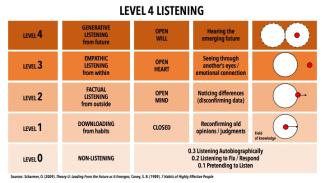Would you say you are a good listener?
I would have said I was a reasonably good listener until I saw this chart on the Four Levels of Listening during a TCL presentation a few years ago!

Being a good listener—and, therefore, a good feedback receiver—is not as simple as it sounds. Not only is there often a lot of discomfort around performance reviews and feedback sessions but there are quite a few obstacles to being both a good feedback giver and a receiver.
But, as in all things related to becoming a Complete Leader, there are actions you can take to grow the skill of receiving feedback with ease and grace. I like to refer to Douglas Stone and Sheila Heen’s book, Thanks for the Feedback, but there are endless resources out there on taking the feedback you are given and learning from it.
Consider and work on implementing these six tips for receiving feedback and you may find those performance reviews are no longer uncomfortable, but instead are opportunities for open conversations that help you grow.
Just listen. Check in with yourself and your fight-or-flight response. It’s not always easy, but it is crucial to be able to absorb the feedback being given to you so that you can either act on it (if the person knows you and is trying to help you) or simply say, “Thank you,” and move on (if they aren’t trying to help you or their feedback is unreliable).
You may also find your reactions are not simply fight-or-flight. In uncomfortable situations some people will also “fawn” or “freeze.” Often it is the feedback giver who fawns once they see someone start to get uncomfortable. They’ll go on about all of the great things the receiver does in an attempt to make the conversation positive. A feedback receiver might also freeze and remove themself from the conversation because they’ve become uncomfortable and will no longer be able to absorb any of the feedback.
Avoid wrong-spotting. Listening is not always easy, and one of the biggest challenges in listening well is avoiding wrong-spotting. Sometimes when you are given feedback, you’ll find yourself looking for what’s wrong with it—and you’ll almost always find something. Maybe you’re tired or not in the mood, perhaps the person is describing a situation in which your experience was different from theirs, maybe they are giving you evaluation feedback when you really need appreciation feedback, or maybe you don’t trust them to give you helpful, unbiased feedback. It could be many things. Be aware of this tendency and try to be a Level 3 or Level 4 listener by listening with an open heart. Ask yourself why you see it differently, what makes sense about what they are saying, and what is worth trying.
Don’t justify, clarify. Always ask more questions. If the feedback is vague, ask, “What could I do differently in the future to produce a better outcome?” or “What specifically did I do that caused you to think that way?” This can help you identify root causes of the feedback. Justifying often doesn’t gain you any clarity and leaves you sounding defensive. It puts you into a heightened neurophysiological state that shuts down your ability to evaluate, reflect, and be creative in your thinking, and you end up losing out on feedback you could have learned from.
Reflect. After receiving feedback, it helps to consider if the person who gave it is trying to help you and coach you. If they are, you can listen and learn. If they aren’t, it’s perfectly okay to discard feedback. Follow up with someone else who might know you better to see if the issue is truly a blindspot or ask the feedback giver more open-ended questions. In all, simply sitting with the feedback and considering it with an open mind can help you see the possibilities moving forward.
Know your triggers. There are three types of triggers. A truth trigger is when something just feels off. Maybe the facts are wrong or the giver did not have all of the information at the time. A relationship trigger can be set off by who gave the feedback more so than by what was said. This is more about your relationship with the person, your preconceived notions of them, and how you feel treated by them. An identity trigger undermines something you hold true about yourself. This one can be especially challenging. However, once you know how these different triggers affect you and show up in your body—perhaps your face gets hot or your shoulders tense up—you can give yourself a moment to recognize what’s happening and be objective about the response, rather than shut down.
Be aware of your blindspots. You are blind to your own facial and body language, your own tone, and your patterns of behavior—everyone is. To circumvent that, ask yourself, “How did I get in my own way? Where have I heard this feedback before? Do you see me doing this behavior?” With today’s frequency of virtual meetings, you can even record yourself to observe your own behavioral patterns and reactions later, which can actually help make you aware of your blindspots.
Once you know yourself better, know your triggers and your blindspots, you’ll be able to manage your responses to feedback in a much more positive way. You’ll find yourself learning from these conversations and taking away actionable items to continue growing as a person and as a leader.
Need tips on giving good feedback? Learn more from Tanja here. TCL Members can also watch Tanja's Personal Leadership Hour on Trends and Best Practices in Performance Feedback for free. Not a member? Join today.
Photo by RDNE Stock project via Pexels.
